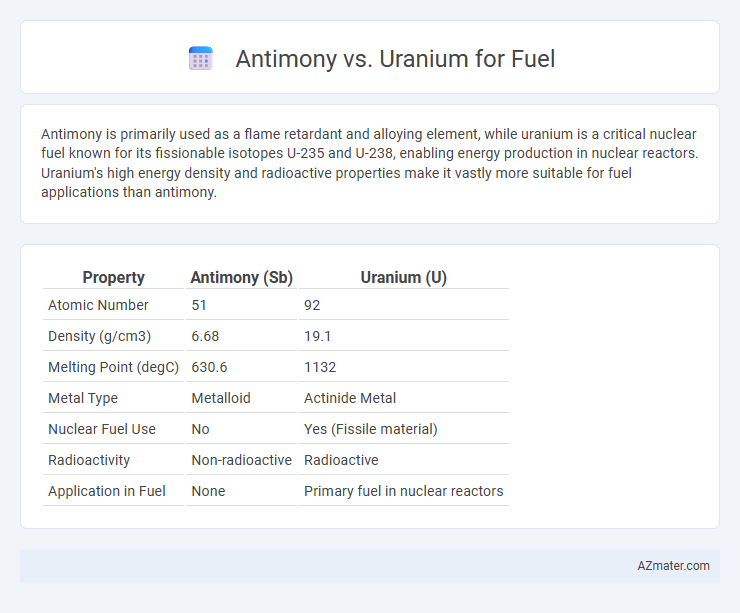Antimony is primarily used as a flame retardant and alloying element, while uranium is a critical nuclear fuel known for its fissionable isotopes U-235 and U-238, enabling energy production in nuclear reactors. Uranium's high energy density and radioactive properties make it vastly more suitable for fuel applications than antimony.
Table of Comparison
| Property | Antimony (Sb) | Uranium (U) |
|---|---|---|
| Atomic Number | 51 | 92 |
| Density (g/cm3) | 6.68 | 19.1 |
| Melting Point (degC) | 630.6 | 1132 |
| Metal Type | Metalloid | Actinide Metal |
| Nuclear Fuel Use | No | Yes (Fissile material) |
| Radioactivity | Non-radioactive | Radioactive |
| Application in Fuel | None | Primary fuel in nuclear reactors |
Introduction: Comparing Antimony and Uranium as Fuel Sources
Antimony and uranium present distinct characteristics as fuel sources with uranium widely recognized for its high energy density and critical role in nuclear reactors, enabling efficient electricity generation. Antimony, though less common as a primary fuel, is valued for its use in battery technology and flame retardants rather than as a direct energy source. The comparison highlights uranium's dominance in nuclear energy production, while antimony serves niche applications related to energy storage and safety materials.
Chemical and Physical Properties Overview
Antimony is a metalloid with a melting point of 631degC and low nuclear reactivity, making it unsuitable for fuel applications in nuclear reactors. Uranium, a dense actinide metal with a melting point of 1132degC, possesses fissile isotopes (U-235) essential for sustaining nuclear chain reactions in fuel rods. The contrasting chemical stability and neutron absorption cross-sections of antimony and uranium underpin uranium's dominance as a nuclear fuel material.
Abundance and Availability in Nature
Antimony occurs in the Earth's crust at approximately 0.2 parts per million, making it relatively scarce but more widespread in mineral deposits compared to uranium, which averages around 2.7 parts per million in the crust. Uranium's availability is concentrated in specific regions, often found in economically viable quantities within sandstone and granite formations, whereas antimony is typically extracted from stibnite ores. While uranium is the primary fuel for nuclear reactors due to its high energy density, antimony's limited abundance and current technological applications restrict its feasibility as a widespread fuel source.
Energy Density and Efficiency
Uranium displays a significantly higher energy density than antimony, producing around 79,500,000 MJ/kg compared to antimony's approximate 10 MJ/kg, making it vastly more efficient for fuel use in nuclear reactors. The efficiency of uranium as fuel is further amplified by its ability to sustain a controlled chain reaction, whereas antimony lacks nuclear fission properties and is primarily used in other industrial applications. Consequently, uranium's superior energy density and fission efficiency make it the preferred choice for energy generation in nuclear power plants.
Applications in Energy Production
Antimony and uranium serve distinct roles in energy production, with uranium primarily utilized as a critical fuel in nuclear reactors due to its high energy density and ability to sustain fission chain reactions. Uranium's isotopes, especially U-235, enable efficient generation of large-scale electricity in nuclear power plants, contributing significantly to low-carbon energy grids. In contrast, antimony is not used as a fuel but finds application in energy production through its role in flame retardants and lead-acid batteries, enhancing safety and performance rather than serving as a primary energy source.
Safety and Environmental Concerns
Antimony as a fuel presents lower radiological hazards compared to uranium, significantly reducing risks of nuclear contamination and long-term environmental radiation. Uranium's radioactive properties demand stringent safety protocols to manage radiation exposure, nuclear waste, and potential proliferation hazards. Antimony's chemical toxicity remains a concern, but its environmental impact is generally easier to contain and remediate than uranium's persistent radioactive waste.
Cost and Economic Viability
Antimony as a fuel source remains largely experimental with limited commercial application, resulting in high costs due to scarce infrastructure and extraction challenges. Uranium, by contrast, benefits from well-established nuclear technology, offering lower fuel costs per energy unit and significant economies of scale in power generation. The economic viability of uranium surpasses antimony, driven by uranium's high energy density and mature fuel cycle technologies, making it the preferred choice for large-scale nuclear energy production.
Waste Management and Byproducts
Antimony fuel produces less radioactive waste compared to uranium, resulting in simpler and safer waste management processes due to its lower radiotoxicity. Uranium-based fuel generates high-level radioactive byproducts, necessitating extensive containment, cooling, and long-term storage solutions to mitigate environmental and health risks. The complexity and cost of handling uranium waste surpass those of antimony, influencing the overall sustainability and environmental impact of these fuel options.
Technological Advancements in Fuel Utilization
Technological advancements in fuel utilization have enhanced antimony's role as a catalyst in nuclear fuel processing, improving efficiency in isotope separation and fuel recycling. Uranium remains the primary fuel for nuclear reactors, with innovations in enrichment and fuel fabrication increasing its energy density and burnup rates, thereby extending reactor cycles. Research in hybrid systems combining antimony-based compounds with uranium fuel promises to optimize thermal conductivity and reduce radioactive waste.
Future Prospects and Industry Trends
Antimony shows potential as an additive in advanced fuel formulations due to its ability to enhance combustion efficiency and reduce emissions, attracting interest for sustainable energy applications. Uranium remains dominant in nuclear fuel, with ongoing innovations in fuel cycle technology and small modular reactors driving its future relevance in low-carbon power generation. Industry trends indicate a growing emphasis on uranium's role in next-generation nuclear reactors, while antimony's contribution is primarily in niche fuel performance enhancements and emerging clean energy sectors.

Infographic: Antimony vs Uranium for Fuel
 azmater.com
azmater.com